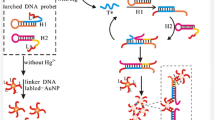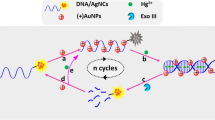Abstract
Inspired by the increasing use of plasmonic gold and silver nanoplates as probes for diverse analytes, the research community often questions which metal nanoplates should be chosen for a given application. A comparative study was performed on the performance and physicochemical properties of three types of metal nanoplates for use in plasmonic detection of Hg(II) ion. Specifically, gold, silver and Ag@Au nanoplates were studied. The established amalgamation method integrated into a detection scheme using nanoplates affords a unique yet straightforward signaling and extraction route for selective recognition of Hg(II) ion. Upon transformation of Hg(II) ion to metallic mercury, nanoplate amalgamation takes place instantly. This reshapes both the morphology and the optical characteristics of nanoplates. It is found that gold and Ag@Au nanoplates enable highly selective quantitation of Hg(II) ion by using a DNA oligomer consisting of poly-deoxycytidine (poly(C)) as a masking agent against Ag(I) ion. The silver nanoplates, in turn, display the best sensitivity owing to the chemical instability. The induced surface plasmonic shifts (of up to 250 nm and color changes from red to green) allows for determination of Hg(II) over a wide range and with a limit of detection of ~10 nM. It is recommended that the gold and Ag@Au nanoplates are used in relatively complex systems, while silver nanoplates are suited for simple matrices.

The amalgamation process integrated with metal (e.g., Au, Ag and Ag@Au) nanoplates affords plasmonic detection of Hg(II) ion with the aid of a poly(c) DNA sequence as the masking agent for Ag(I) ion.





Similar content being viewed by others
References
Tchounwou PB, Yedjou CG, Patlolla AK, Sutton DJ (2012) Heavy metal toxicity and the environment. In: Molecular, clinical and environmental toxicology: volume 3: environmental toxicology. Springer
Beal SA, Osterberg EC, Zdanowicz CM, Fisher DA (2015) Ice core perspective on mercury pollution during the past 600 years. Environ Sci Technol 49:7641–7647
Driscoll CT, Mason RP, Chan HM, Jacob DJ, Pirrone N (2013) Mercury as a global pollutant: sources, pathways, and effects. Environ Sci Technol 47:4967–4983
Harada M (1995) Minamata disease: methylmercury poisoning in Japan caused by environmental pollution. Crit Rev Toxicol 25:1–24
Bortoli A, Gerotto M, Marchiori M, Muntau H, Rehnert A (1995) Critical comparison of methods for mercury determination in fish. Microchim Acta 119:305–310
Martín-Yerga D, González-García MB, Costa-García A (2013) Electrochemical determination of mercury: a review. Talata 116:1091–1104
Díez-Gil C, Martínez R, Ratera I, Hirsh T, Espinosa A (2011) Selective picomolar detection of mercury(II) using optical sensors. Chem Commun 47:1842
Chansuvarn W, Tuntulani T, Imyim A (2015) Colorimetric detection of mercury(II) based on gold nanoparticles, fluorescent gold nanoclusters and other gold-based nanomaterials. Trac-trend Anal Chem 65:83–96
Wang G, Wang Y, Chen L (2010) Nanomaterial-assisted aptamers for optical sensing. Biosens Bioelectron 25:1859–1868
Ghosh SK, Pal T (2007) Interparticle coupling effect on the surface plasmon resonance of gold nanoparticles: from theory to applications. Chem Rev 107:4797–4862
Wang J, Liu B (2008) Highly sensitive and selective detection of Hg2+ in aqueous solution with mercury-specific DNA and Sybr Green I. Chem Commun 44:4759–4761
Liu X, Tang Y, Wang L, Zhang J (2007) Optical detection of mercury(II) in aqueous solutions by using conjugated polymers and label-free oligonucleotides. Adv Mater 19:1662–1662
Kolpashchikov DM (2008) Split DNA enzyme for visual single nucleotide polymorphism typing. J Am Chem Soc 130:2934–2935
Knecht MR, Sethi M (2009) Bio-inspired colorimetric detection of Hg2+ and Pb2+ heavy metal ions using Au nanoparticles. Anal Bioanal Chem 394:33–46
Lee J-S, Mirkin CA (2008) Chip-based scanometric detection of mercuric ion using DNA-functionalized gold nanoparticles. Anal Chem 80:6805–6808
Su D, Yang X, Xia Q, Chai F, Wang C, Qu F (2013) Colorimetric detection of Hg2+ using thioctic acid functionalzied gold nanoparticles. RSC Adv 3:24618–24624
Liu CW, Hsieh YT, Huang CC, Lin ZH, Chang HT (2008) Detection of mercury(II) based on Hg2+-DNA complexes inducing the aggregation of gold nanoparticles. Chem Commun (Camb):2242–2244
Wang W, Chen C, Qian M, Zhao XS (2008) Aptamer biosensor for protein detection using gold nanoparticles. Anal Biochem 373:213–219
Rex M, Hernandez FE, Campiglia AD (2006) Pushing the limits of mercury sensors with gold nanorods. Anal Chem 78:445–451
Wang G, Chen Z, Wang W, Yan B, Chen L (2011) Chemical redox-regulated mesoporous silica-coated gold nanorods for colorimetric probing of Hg2+ and S2−. Analyst 136:174–178
Atkins P, Paula JD (2006) Physical chemistry, 8th edn. Oxford Univ. Press, New York
Wang G, Tao S, Liu Y, Guo L, Qin G, Ijiro K, Maeda M, Yin Y (2016) High-yield halide-free synthesis of biocompatible Au nanoplates. Chem Commun 52:398–401
Chen L, Ji F, Xu Y, He L, Mi Y, Bao F, Sun B, Zhang X, Zhang Q (2014) High-yield seedless synthesis of triangular gold nanoplates through oxidative etching. Nano Lett 14:7201–7206
Wang G, Akiyama Y, Takarada T, Maeda M (2016) Rapid non-crosslinking aggregation of DNA-functionalized gold nanorods and nanotriangles for colorimetric single-nucleotide discrimination. Chem-Eur J 22:258–263
Chang C-C, Wang G, Takarada T, Maeda M (2017) Iodine-mediated etching of triangular gold nanoplates for colorimetric sensing of copper ion and aptasensing of chloramphenicol. ACS Appl Mater Interfaces 9:34518–34525
Zhao C, Wang G, Takarada T, Liang X, Komiyama M, Maedab M (2019) Shape-selective isolation of au nanoplates from complex colloidal media by depletion flocculation. Colloid Surface A 568:216–223
Zhang Q, Li N, Goebl J, Lu Z, Yin Y (2011) A systematic study of the synthesis of silver nanoplates: is citrate a “magic” reagent? J Am Chem Soc 133:18931–18939
Gao C, Lu Z, Liu Y, Zhang Q, Chi M, Cheng Q, Yin Y (2012) Highly stable silver nanoplates for surface plasmon resonance biosensing. Angew Chem Int Ed Eng 51:5629–5633
Jin L-H, Han C-S (2014) Eco-friendly colorimetric detection of mercury(II) ions using label-free anisotropic nanogolds in ascorbic acid solution. Sensor Actuat B-Chem 195:239–245
Chaudhary A, Dwivedi C, Chawla M, Gupta A, Nandi CK (2015) Lysine and dithiothreitol promoted ultrasensitive optical and colorimetric detection of mercury using anisotropic gold nanoparticles. J Mater Chem C 3:6962–6965
Wang Y, Yang F, Yang X (2010) Colorimetric biosensing of mercury(II) ion using unmodified gold nanoparticle probes and thrombin-binding aptamer. Biosens Bioelectron 25:1994–1998
Shiva PK, Govindaraju S, Chandan S (2018) Functionalized silver nano-sensor for colorimetric detection of Hg2+ ions: facile synthesis and docking studies. Sensors 18:2698
Chen L, Fu X, Lu W, Chen L (2013) Highly sensitive and selective colorimetric sensing of Hg2+ based on the morphology transition of silver nanoprisms. ACS Appl Mater Interfaces 5:284–290
Ono A, Cao S, Togashi H, Tashiro M, Fujimoto T, Machinami T, Oda S, Miyake Y, Okamoto I, Tanaka Y (2008) Specific interactions between silver(I) ions and cytosine–cytosine pairs in DNA duplexes. Chem Commun 44:4825–4827
Hu S, Yi T, Huang Z, Liu B, Wang J, Yi X, Liu J (2019) Etching silver nanoparticles using DNA. Mater Horiz 6:155–159
Acknowledgments
This study was supported by a Natural Science Foundation of China for Young Researchers (No. 21805263) and a START-UP Fund from Ocean University of China.
Author information
Authors and Affiliations
Corresponding authors
Ethics declarations
Conflict of interest
The authors declare that they have no competing interests.
Additional information
Publisher’s note
Springer Nature remains neutral with regard to jurisdictional claims in published maps and institutional affiliations.
Electronic supplementary material
ESM 1
Supporting Information. Detailed synthetic protocols, additional TEM images, spectral analysis and control experimental results. (DOCX 1.75 mb)
Rights and permissions
About this article
Cite this article
Zhang, Y., Zhang, L., Wang, L. et al. Colorimetric determination of mercury(II) ion based on DNA-assisted amalgamation: a comparison study on gold, silver and Ag@Au Nanoplates. Microchim Acta 186, 713 (2019). https://doi.org/10.1007/s00604-019-3873-z
Received:
Accepted:
Published:
DOI: https://doi.org/10.1007/s00604-019-3873-z




